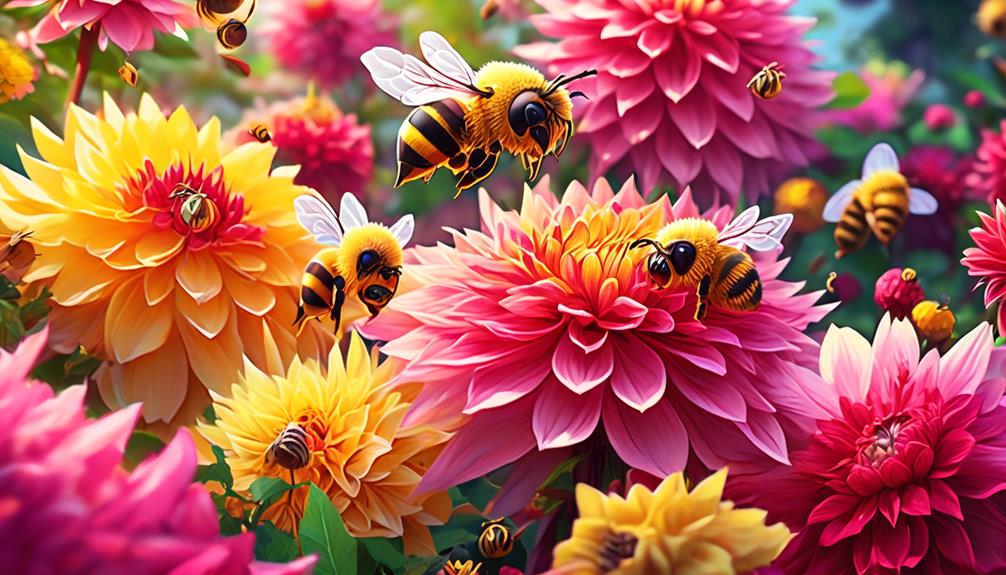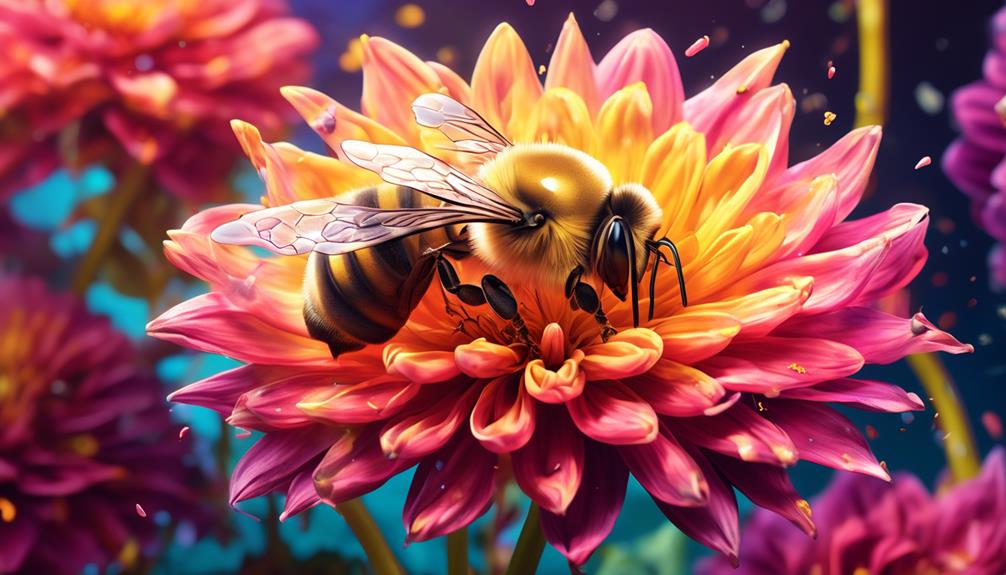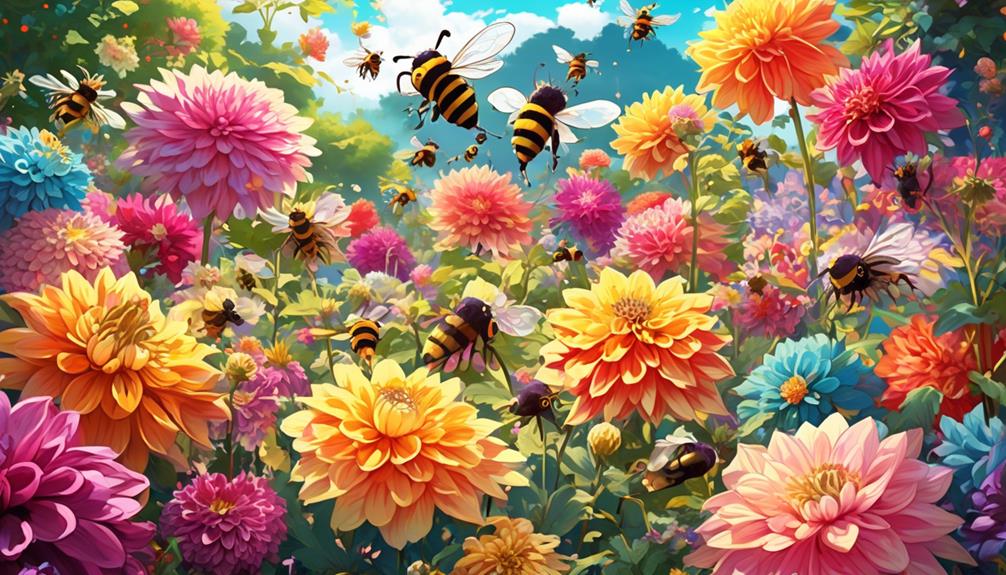Know more about the intriguing relationship between bees and dahlias and discover if your garden can become a bee paradise.

Do Bees Like Dahlias?
Did you know that there are over 20,000 different species of bees worldwide, all with varying flower preferences?
As a gardener or nature enthusiast, you might find it fascinating to understand which flowers, specifically, attract these industrious pollinators.
Dahlias, with their vibrant colors and intricate patterns, are certainly captivating to the human eye, but do they hold the same appeal for bees?
As we explore this topic, you'll discover more about the relationship between bees and dahlias, and whether your garden could become a buzzing haven for these crucial creatures.
Key Takeaways
- Bees are attracted to dahlias due to their bright, contrasting colors, symmetrical petals, and pleasant fragrance.
- Dahlias serve as a valuable source of nectar and pollen for bees, leading to frequent visits.
- Planting a variety of dahlia types, along with other bee-friendly plants, can increase bee visits to your garden.
- Bees play a crucial role in the propagation of flowering plants, including dahlias, through pollination.
Understanding Bee Preferences

To truly appreciate the relationship between bees and dahlias, it's imperative to dive into the intricate world of bee preferences based on scientific studies. You'll find that bees aren't as indiscriminate as you might think. On the contrary, they're quite picky when it comes to their floral choices.
Research reveals that color, symmetry, scent, and nectar availability are key factors that influence bee preferences. Bees have an affinity for bright, contrasting colors. They're especially drawn to blue, violet, and yellow hues. So, if you're planning a garden that attracts bees, dahlias with these colors could be a smart choice.
Symmetry, too, plays an important role. Bees tend to prefer radially symmetrical flowers like dahlias because they provide a landing platform. Furthermore, a flower's scent can either attract or repel bees. Dahlias emit a mild, pleasant aroma that bees find inviting.
Lastly, nectar availability is a major draw for bees. Dahlias, with their plentiful nectar supply, are a veritable feast for these pollinators.
Understanding these preferences can help you create a bee-friendly environment. So, if you're aiming to attract bees, keep these factors in mind when choosing dahlias for your garden.
Dahlias: An Overview

Now, let's delve into the world of dahlias, a diverse group of plants known for their stunning blooms and bee-friendly attributes.
Originating from the high regions of Mexico and Guatemala, dahlias consist of 42 species, with thousands of cultivars. They're members of the Asteraceae family, which also includes daisies and sunflowers.
Dahlias are perennials, meaning they can regrow for several years. They bloom from midsummer up until the first frost, providing a continuous food source for bees. Their flowers range in size, from as small as 2 inches to as large as a dinner plate, and can be found in nearly every color imaginable.
You'll find that dahlias are tuberous plants, storing their nutrients in an underground structure similar to a bulb. This allows them to survive harsh winters if properly stored. When considering dahlias for your garden, they prefer well-drained, sandy or loamy soil, and a sunny location. They're somewhat salt and drought tolerant, but for optimal growth, regular watering and fertilizing are recommended.
For the bees, dahlias offer both nectar and pollen, making them a valuable source of food. However, bees tend to prefer single-flowering varieties, as they provide easier access to these resources.
The Attraction Between Bees and Flowers

Understanding the attraction between bees and flowers requires a dive into the fascinating world of pollination. Here, you'll discover how bees play a vital role in the survival and propagation of flowering plants such as dahlias. Bees possess an exquisite sense of smell that allows them to identify flowers loaded with nectar and pollen – their primary food source.
This attraction isn't a one-way street. Flowers, in their quest for reproduction, emit enticing fragrances and display vibrant colors to draw bees. Dahlias, with their lush, bright petals, are particularly alluring. Once a bee lands on a dahlia, it gets dusted with pollen. As the bee moves from flower to flower, it inadvertently transfers this pollen, facilitating cross-pollination.
The relationship between bees and dahlias is symbiotic. Bees get their sustenance, and dahlias get a helping hand in reproduction. Moreover, this cross-pollination leads to genetic diversity among dahlias, enhancing their resilience against environmental stressors.
Do Bees Visit Dahlias?

Despite assumptions that dahlias, with their vivid allure, may not be a preferred choice for bees due to their complex petal arrangement, scientific observations have confirmed that bees indeed visit these vibrant blossoms frequently. You might wonder why. Well, it's the nectar and pollen that dahlias produce that attract these buzzing pollinators.
Research shows that bees are drawn to dahlias' rich nectar, which provides them with essential nutrients. Despite the intricate petal structure, bees have evolved sophisticated navigation techniques, enabling them to delve into the heart of the flower. They're not deterred by the labyrinth of petals, rather, they're enticed by it.
Furthermore, recent studies indicate that bees' color perception is acute, and they're particularly attracted to bright hues. Dahlias, blooming in a spectrum of vivid colors, naturally become a visual beacon for bees. Their bold, contrasting patterns are believed to serve as nectar guides, directing bees to the flower's center.
Increasing Bee Visits to Your Garden

If you're interested in seeing more bees buzzing around your garden, there are several scientifically-proven strategies that you can implement to attract these pollinators to your dahlias.
First off, you can plant a variety of dahlia types. Research indicates that bees are attracted to diversity, particularly large, open-centered dahlias with single rows of petals.
Secondly, consider incorporating other bee-friendly plants into your garden. Plants like lavender, foxgloves, and marjoram are known to attract bees. Studies consistently show that a diverse plant environment encourages bee visits.
You should also avoid using pesticides, as these can be harmful to bees. Instead, opt for organic gardening methods. If pest control is necessary, choose products that are bee-friendly. Research has shown that bees are more likely to visit gardens that are free from harmful chemicals.
Lastly, provide a water source for bees. A shallow dish filled with water and pebbles can act as a perfect drinking spot. Bees need water to survive and are more likely to visit gardens where water is readily available.
Frequently Asked Questions
What Other Types of Flowers Do Bees Typically Prefer Apart From Dahlias?
You're curious about the floral preferences of bees, aren't you?
Bees typically enjoy a variety of flowers. They're particularly attracted to lavender, borage, and marjoram due to their high nectar content. Sunflowers, honeysuckle, and foxgloves also make the list because of their bright colors and sweet scents.
However, it's important to note that bees' preferences can vary depending on the species and local flora.
What Are the Different Types of Dahlias That Exist and Do Bees Have a Preference?
Yes, there are numerous types of dahlias that exist, from pompon to cactus varieties. However, it isn't really about the type of dahlia.
Instead, bees are more attracted to dahlias with open centers, where they can easily access the nectar. So, while they'll visit all dahlias, they're particularly fond of single-flowering varieties with less dense petals.
It's more about accessibility, not the specific dahlia type. Bees aren't fussy, they're practical!
Can the Presence of Bees Affect the Growth or Health of Dahlias?
Yes, bees can impact the health of your dahlias. They play a crucial role in pollination, which is vital for the reproduction of many plants.
When bees visit your dahlias, they collect pollen and nectar, inadvertently fertilizing the flowers in the process. This helps the dahlias to produce seeds and ensure their survival.
Therefore, the presence of bees can actually improve the growth and overall health of your dahlias.
Are There Certain Types of Bees That Are More Attracted to Dahlias Than Others?
Yes, certain types of bees are more attracted to dahlias than others. Specifically, honeybees and bumblebees find dahlias particularly appealing.
Their attraction is due to the dahlia's bright colors and large, flat petals, which provide an easy landing platform. Dahlias also produce a lot of nectar, which these bees need for their survival.
Can Using Certain Fertilizers or Garden Treatments Discourage Bees From Visiting Dahlias?
Yes, certain fertilizers and garden treatments can indeed discourage bees from visiting dahlias. It's important to note, harsh chemicals or pesticides may deter bees or harm them.
You're better off using organic, bee-friendly options. Keep in mind, bees are attracted to the natural scent of flowers. If a treatment alters this smell, it could potentially make the dahlias less appealing to the bees.
Always consider the impact of your gardening choices on local wildlife.
Conclusion
In conclusion, bees do indeed visit dahlias. Their vivid colors and ample nectar supply are irresistible to these diligent pollinators.
However, not all dahlias are created equal in a bee's eyes; they prefer open-centered varieties. So, if you're keen on boosting your garden's bee activity, including these types of dahlias is a smart move.
Remember, a garden buzzing with bees is a sign of a healthy, thriving ecosystem.


